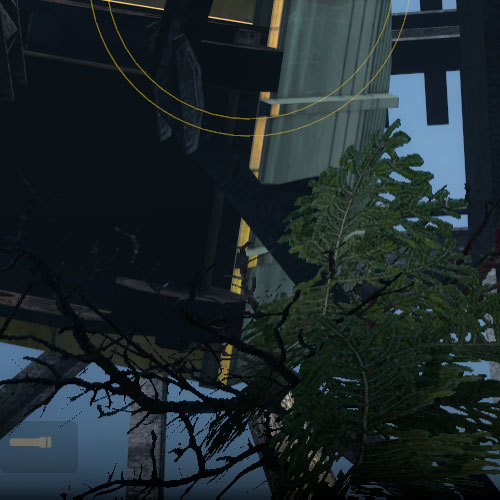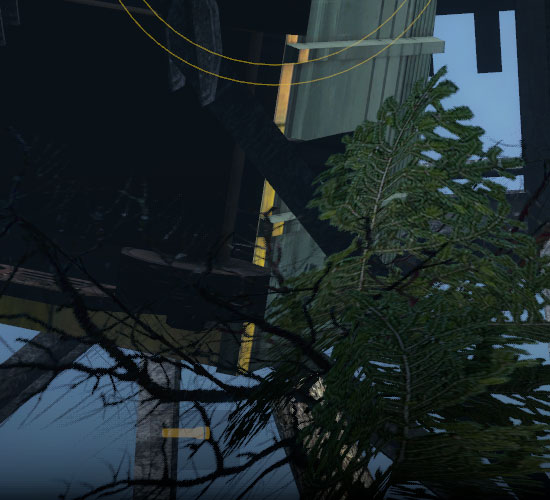AMD's Radeon HD 5870: Bringing About the Next Generation Of GPUs
by Ryan Smith on September 23, 2009 9:00 AM EST- Posted in
- GPUs
The Return of Supersample AA
Over the years, the methods used to implement anti-aliasing on video cards have bounced back and forth. The earliest generation of cards such as the 3Dfx Voodoo 4/5 and ATI and NVIDIA’s DirectX 7 parts implemented supersampling, which involved rendering a scene at a higher resolution and scaling it down for display. Using supersampling did a great job of removing aliasing while also slightly improving the overall quality of the image due to the fact that it was sampled at a higher resolution.
But supersampling was expensive, particularly on those early cards. So the next generation implemented multisampling, which instead of rendering a scene at a higher resolution, rendered it at the desired resolution and then sampled polygon edges to find and remove aliasing. The overall quality wasn’t quite as good as supersampling, but it was much faster, with that gap increasing as MSAA implementations became more refined.
Lately we have seen a slow bounce back to the other direction, as MSAA’s imperfections became more noticeable and in need of correction. Here supersampling saw a limited reintroduction, with AMD and NVIDIA using it on certain parts of a frame as part of their Adaptive Anti-Aliasing(AAA) and Supersample Transparency Anti-Aliasing(SSTr) schemes respectively. Here SSAA would be used to smooth out semi-transparent textures, where the textures themselves were the aliasing artifact and MSAA could not work on them since they were not a polygon. This still didn’t completely resolve MSAA’s shortcomings compared to SSAA, but it solved the transparent texture problem. With these technologies the difference between MSAA and SSAA were reduced to MSAA being unable to anti-alias shader output, and MSAA not having the advantages of sampling textures at a higher resolution.
With the 5800 series, things have finally come full circle for AMD. Based upon their SSAA implementation for Adaptive Anti-Aliasing, they have re-implemented SSAA as a full screen anti-aliasing mode. Now gamers can once again access the higher quality anti-aliasing offered by a pure SSAA mode, instead of being limited to the best of what MSAA + AAA could do.
Ultimately the inclusion of this feature on the 5870 comes down to two matters: the card has lots and lots of processing power to throw around, and shader aliasing was the last obstacle that MSAA + AAA could not solve. With the reintroduction of SSAA, AMD is not dropping or downplaying their existing MSAA modes; rather it’s offered as another option, particularly one geared towards use on older games.
“Older games” is an important keyword here, as there is a catch to AMD’s SSAA implementation: It only works under OpenGL and DirectX9. As we found out in our testing and after much head-scratching, it does not work on DX10 or DX11 games. Attempting to utilize it there will result in the game switching to MSAA.
When we asked AMD about this, they cited the fact that DX10 and later give developers much greater control over anti-aliasing patterns, and that using SSAA with these controls may create incompatibility problems. Furthermore the games that can best run with SSAA enabled from a performance standpoint are older titles, making the use of SSAA a more reasonable choice with older games as opposed to newer games. We’re told that AMD will “continue to investigate” implementing a proper version of SSAA for DX10+, but it’s not something we’re expecting any time soon.
Unfortunately, in our testing of AMD’s SSAA mode, there are clearly a few kinks to work out. Our first AA image quality test was going to be the railroad bridge at the beginning of Half Life 2: Episode 2. That scene is full of aliased metal bars, cars, and trees. However as we’re going to lay out in this screenshot, while AMD’s SSAA mode eliminated the aliasing, it also gave the entire image a smooth makeover – too smooth. SSAA isn’t supposed to blur things, it’s only supposed to make things smoother by removing all aliasing in geometry, shaders, and textures alike.
As it turns out this is a freshly discovered bug in their SSAA implementation that affects newer Source-engine games. Presumably we’d see something similar in the rest of The Orange Box, and possibly other HL2 games. This is an unfortunate engine to have a bug in, since Source-engine games tend to be heavily CPU limited anyhow, making them perfect candidates for SSAA. AMD is hoping to have a fix out for this bug soon.
“But wait!” you say. “Doesn’t NVIDIA have SSAA modes too? How would those do?” And indeed you would be right. While NVIDIA dropped official support for SSAA a number of years ago, it has remained as an unofficial feature that can be enabled in Direct3D games, using tools such as nHancer to set the AA mode.
Unfortunately NVIDIA’s SSAA mode isn’t even in the running here, and we’ll show you why.

5870 SSAA

GTX 280 MSAA

GTX 280 SSAA
At the top we have the view from DX9 FSAA Viewer of ATI’s 4x SSAA mode. Notice that it’s a rotated grid with 4 geometry samples (red) and 4 texture samples. Below that we have NVIDIA’s 4x MSAA mode, a rotated grid with 4 geometry samples and a single texture sample. Finally we have NVIDIA’s 4x SSAA mode, an ordered grid with 4 geometry samples and 4 texture samples. For reasons that we won’t get delve into, rotated grids are a better grid layout from a quality standpoint than ordered grids. This is why early implementations of AA using ordered grids were dropped for rotated grids, and is why no one uses ordered grids these days for MSAA.
Furthermore, when actually using NVIDIA's SSAA mode, we ran into some definite quality issues with HL2: Ep2. We're not sure if these are related to the use of an ordered grid or not, but it's a possibility we can't ignore.
If you compare the two shots, with MSAA 4x the scene is almost perfectly anti-aliased, except for some trouble along the bottom/side edge of the railcar. If we switch to SSAA 4x that aliasing is solved, but we have a new problem: all of a sudden a number of fine tree branches have gone missing. While MSAA properly anti-aliased them, SSAA anti-aliased them right out of existence.
For this reason we will not be taking a look at NVIDIA’s SSAA modes. Besides the fact that they’re unofficial in the first place, the use of a rotated grid and the problems in HL2 cement the fact that they’re not suitable for general use.












327 Comments
View All Comments
Ryan Smith - Wednesday, September 23, 2009 - link
We do have Cyberlink's software, but as it uses different code paths, the results are near-useless for a hardware review. Any differences could be the result of hardware differences, or it could be that one of the code paths is better optimized. We would never be able to tell.Our focus will always be on benchmarking the same software on all hardware products. This is why we bent over backwards to get something that can use DirectCompute, as it's a standard API that removes code paths/optimizations from the equation (in this case we didn't do much better since it was a NVIDIA tech demo, but it's still an improvement).
DukeN - Wednesday, September 23, 2009 - link
I have one of these and I know it outperforms the GTX 280 but not sure what it'd be like against one of these puppies.dagamer34 - Wednesday, September 23, 2009 - link
I need my bitstream Dolby Digital TrueHD/DTS HD Master Audio bistreaming codecs!!! :)ew915 - Wednesday, September 23, 2009 - link
I don't see this beating the GT300 as for so it should beat the GTX295 by a great margin.tamalero - Wednesday, September 23, 2009 - link
dood, you forgot the 295 is a DUAL CHIP?SiliconDoc - Wednesday, September 23, 2009 - link
roflmao - Gee no more screaming the 4850x2 and the 4870x2 are best without pointing out the two gpu's needed to get there.--
Nonetheless, this 5870 is EPIC FAIL, no matter what - as we see the disappointing numbers - we all see them, and it's not good.
---
Problem is, Nvidia has the MIMD multiple instructions breakthrough technology never used before that according to reports is an AWESOME advantage, lus they are moving to DDR5 with a 512 bit bus !
--
So what is in the works is an absolute WHOMPING coming down on ati that BIG GREEN NVIDIA is going to deliver, and the poor numbers here from what was hoped for and hyped over (although even PREDICTED by the red fan Derek himself in one portion of one sorrowful and despressed sentence on this site) are just one step closer to that nail in the coffin...
--
Yes I sure hope ati has something major up it's sleeve, like 512 bit mem bus increased card coming, the 5870Xmem ...
I find the speculation that ATI "mispredicted" the bandwidth needs to be utter non-sense. They are 2-3 billion in the hole from the last few years with "all these great cards" they still lose $ on every single sale, so they either cannot go higher bit width, or they don't want to, or they are hiding it for the next "strike at NVidia" release.
erple2 - Friday, September 25, 2009 - link
So you're comparing this product with a not yet release product and saying that the not yet released product is going to trounce it, without any facts to back it up? Do you have the hardware? If not, then you're simply ranting.Will the GT300 beat out the 5870? I dunno, probably. If it didn't, that would imply that the move from GT200 to GT300 was a major disappointment for NVidia.
I think that EPIC FAIL is completely ludicrous. I can see "epic fail" applied to the Geforce FX series when it came out. I can also see "epic fail" for the Radeon MAXX back in the day. But I don't see the 5870 as "epic fail". If you look at the card relative to the 4870 (the card it replaces), it's quite good - solid 30% increase. That's what I would expect from a generation improvement (that's what the gt200's did over the 9800's, and what the 8800 did over the 7900, etc).
BTW, I'm seeing the 5870 as pretty good - it beats out all single card NVidia by a reasonable and measureable amount. Sounds like ATI has done well. Or are you considering anything less than 2x the performance of the NVidia cards "epic fail"? In that case, you may be disappointed with the GT300, as well. In fact, I'll say that the GT300 is a total fail right now. I mean jeez! It scores ZERO FPS in every benchmark! That's super-epic fail. And I have the numbers to back that statement up.
Since you are making claims about the epic fail nature of the 5870 based on yet to be released hardware, I can certainly play the same game, and epic fail anything you say based on those speculative musings.
SiliconDoc - Monday, September 28, 2009 - link
Well the GT200 was 60.96% increase average. AT says so.http://www.anandtech.com/video/showdoc.aspx?i=3334...">http://www.anandtech.com/video/showdoc.aspx?i=3334...
So, I guess ati lost this round terribly, as NVidia's last just beat them by more than double your 30%.
Great, EPIC FAIL is correct, I was right, and well...
Finally - Wednesday, September 23, 2009 - link
Team Green foames out of their mouthes. It's funny to watch.SiliconDoc - Wednesday, September 23, 2009 - link
Glad you are having fun.Just let me know when you disagree, and why. I'm certain your fun will be "gone then", since reality will finally take hold, and instead of you seeing foam, I'll be seeing drool.